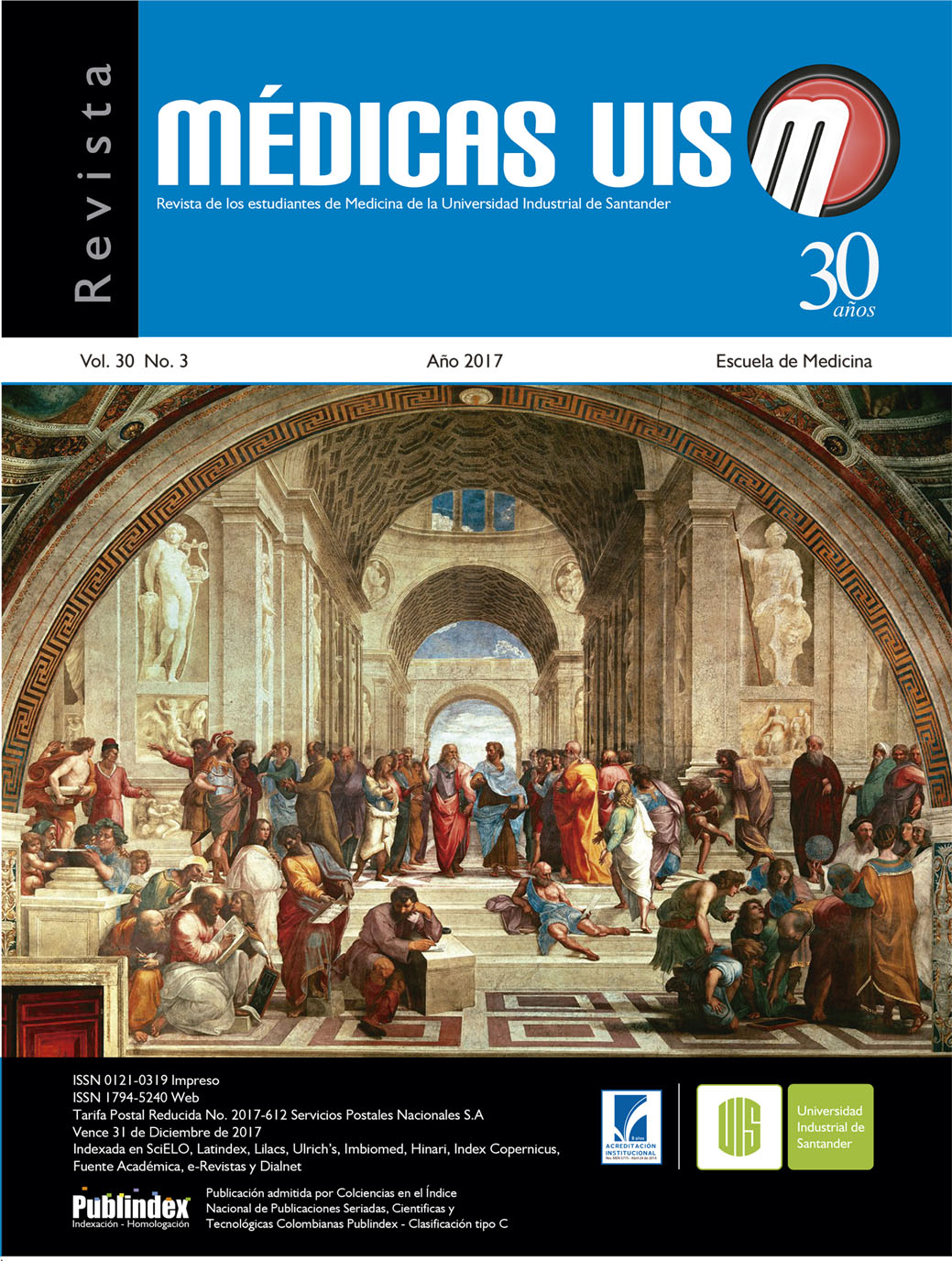Abstract
Introduction: establishing the adequate prognosis in patients with acute myocardial infarction contributes to differentiate their follow-up and facilitates when deciding which specific conduct will determine the best result in its course. Objective: to identify prognostic factors of hospital mortality in patients with ST elevation myocardial infarction. Methods: it was performed a case-control analytic study in patients admitted with ST elevation myocardial infarction in “Arnaldo Milián Castro” hospital during 2015. The case group was integrated by deceased patients (n=15) and the control group by living patients (n=60). During admission, demographic, hemodynamic and laboratory variables were evaluated, and a binary logistic regression was made to identify the predicting factors. Results: medium age (74.13±7.80), glycemia (14.2±10.3) and Leuko-glycemic index (3.097±2.666) were significantly higher in the case group. Electrical (OR:2.00; CI:1.767 to 20.369) and hemodynamic complications (OR:2.00; CI:1.398 a 2.860) predominated in deceased patients. Multivariate analysis identified serum creatinine (OR:1.013; CI:1.010 to 1.027), coronary reperfusion therapy (OR:0.206; CI:0.049 to 0.868) and Killip-Kimball classification (OR:8.311; CI:1.511 to 45.720) as prognostic factors of mortality. Conclusions: the serum creatinine levels, coronary reperfusion therapy and Killip-Kimball classification constituted the prognostic factors of hospital mortality for patients with ST elevation myocardial infarction. An early identification of those factors could indicate that patients need a closer follow-up during admission to improve their prognosis. MÉD.UIS. 2017;30(3):67-72.
References
2. TERIMA Group of Investigators. TERIMA-2: national extension of thrombolytic treatment with recombinant streptokinase in acute myocardial infarct in Cuba. Thromb Haemost. 2000;84(6):949-54.
3. Ministerio de Salud Pública, Dirección de Registros Médicos y Estadísticas en Salud. Anuario Estadístico de Salud 2016. La Habana: Ministerio de Salud Pública de Cuba; 2017.
4. Mega J, Morrow D. Infarto de miocardio con elevación del ST: tratamiento. In: Braunwald E, ed. by. Tratado de Cardiología: Texto de Medicina Cardiovascular. España: Elsevier; 2016. p. 1055-147.
5. León-Aliz E, Moreno-Martínez FL, Pérez-Fernández GA, VegaFleites LF, Rabassa-López-Calleja MA. Índice leuco-glucémico como marcador pronóstico de la evolución intrahospitalaria en pacientes con infarto agudo de miocardio con elevación del ST. Clin Invest Arterioscl. 2014;26(4):168-75.
6. Novo LE, Gómez YdC, Milord Y, Ramos HL. Caracterización de pacientes con infarto miocárdico con elevación del ST complicados no trombolizados. Acta Médica del Centro.
2014;8(1):29-36.
7. Bustaque Y, Pérez L. Comportamiento del lipidograma en pacientes post-infarto agudo del miocardio. Acta Médica del Centro. 2011;5(3):56.
8. González K, Expósito LR, Lugo L, Rodríguez A, Leal JL. Comportamiento del infarto agudo del miocardio en una Sala de Cuidados Intensivos Cardiológicos en el período de un año. Acta Médica del Centro. 2011;5(3):31-2.
9. Thygesen K, Alpert JS, Jaffe AS, Simoons ML, Chaitman BR, White HD, et al. Third universal definition of myocardial infarction. J Am Coll Cardiol. 2012;60(16):1581-98.
10. Villa JJ, Pallás JMA. Métodos de investigación clínica y epidemiológica. 4th ed. España: Elsevier; 2012.
11. Killip T, Kimball JT. Treatment of myocardial infarction in a coronary care unit: a two year experience with 250 patients. Am J Cardiol. 1967;20(4):457-64.
12. Castro W, Conci E, Zelaya F, Isa M, Pacheco G, Sala J, et al. Estratificación del riesgo en el infarto agudo de miocardio según el índice leucoglucémico. ¿El Killip-Kimball de laboratorio?. Rev Fed Arg Cardiol. 2010;39(1):29–34.
13. Pérez JEL, Jiménez RR, Negret AL, Mena MG, Delgado MD, Fernández RV, et al. Factores predictivos de mortalidad en pacientes con infarto agudo del miocardio con elevación del ST. Rev Cubana Cardiol Cir Cardiovasc. 2012;16(4):417-23.
14. Bernat I, Horak D, Stasek J, Mates M, Pesek J, Ostadal P, et al. ST-segment elevation myocardial infarction treated by radial or femoral approach in a multicenter randomized clinical trial: the STEMI-RADIAL trial. J Am Coll Cardiol. 2014;63(10):964-72.
15. Pedersen F, Butrymovich V, Kelbæk H, Wachtell K, Helqvist S, Kastrup J, et al. Short-and long-term cause of death in patients treated with primary PCI for STEMI. J Am Coll Cardiol. 2014;64(20):2101-8.
16. Granger CB, Goldberg RJ, Dabbous O, Pieper KS, Eagle KA, Cannon CP, et al. Predictors of hospital mortality in the global registry of acute coronary events. Arch Intern Med. 2003;163:2345–53.
17. Morrow DA, Antman EM, Charlesworth A, Cairns R, Murphy SA, de Lemos JA, et al. TIMI risk score for ST-elevation myocardial infarction: a convenient, bedside, clinical score for risk assessment at presentation. Circulation. 2000;102(17):2031–7.
18. Reynolds HR, Hochman JS. Cardiogenic Shock Current Concepts and Improving Outcomes. Circulation. 2008;117:686-97.
19. Angeli F, Reboldi G, Poltronieri C, Lazzari L, Sordi M, Garofoli M, et al. Hyperglycemia in acute coronary syndromes: from mechanisms to prognostic implications. Ther Adv Cardiovasc Dis. 2015;9(6):412–24.
20. Koracevic G, Vasiljevic S, Velicković-Radovanović R, Sakac D, Obradovic S, Damjanovic M, et al. Stress hyperglycemia in acute myocardial infarction. Vojnosanit Pregl. 2014;71(9):858-69.
21. Puig Domingo M. Función plaquetaria e hiperglucemia en el síndrome coronario. Rev Esp Card. 2014;67:3–5.
22. Hirschson Prado A, Higa C, Merlo P, Dominé E, Blanco P, Vázquez G, et al. Valor pronóstico del índice leucoglucémico en el infarto agudo de miocardio. Resultados del Registro Multicéntrico SCAR. Rev Fed Arg Cardiol. 2014;82:500-5.
23. Benítez RE, Morales AM, Hernández LM, Sánchez PA, Herrera Y, Rivera EM. Hemoglobina glucosilada e índice leucoglucémico como determinaciones pronósticas en el síndrome coronario agudo. CorSalud. 2016;8(3):153–63.
24. Boersma E. The Primary Coronary Angioplasty vs. Thrombolysis (PCAT)-2 Trialists’ Collaborative Group. Does time matter? A pooled analysis of randomized clinical trials comparing primary percutaneous coronary intervention and in-hospital fibrinolysis in acute myocardial infarction patients. Eur Heart J. 2006;27(7):779-88.
